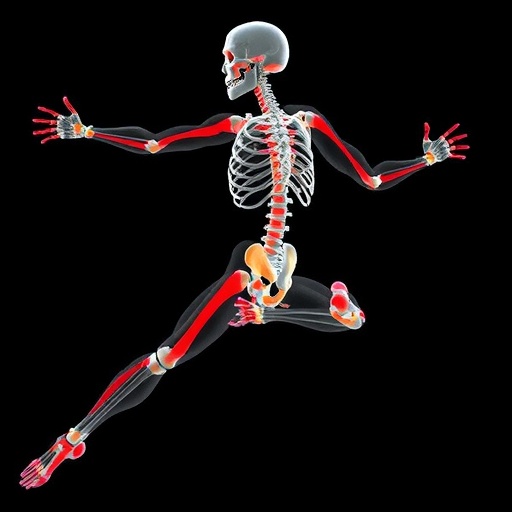Recent advancements in the field of biomechanical engineering have seen researchers delving into complex neuromusculoskeletal modeling as a means to understand and predict human motion and force generation. The investigation led by Babcock, Hamilton, Lykidis, and their colleagues provides a robust framework that merges computational modeling with experimental data. This novel approach aligns with the increasing demand for precise biomechanical assessments in both clinical and sports environments, ultimately enhancing the way practitioners approach rehabilitation and athletic training.
At the heart of this research lies the neuromusculoskeletal system, which intricately connects the nervous system, muscular systems, and skeletal structures. This trifecta works in harmony to facilitate movement, balance, and stability. However, comprehending the interplay among these components has historically posed significant challenges, especially when trying to predict force production during dynamic activities. Researchers have recognized the potential of sophisticated modeling techniques to shed light on these complexities, and that is the foundation of the current study.
The study employed a neuromusculoskeletal model that simulates various movements and tasks, offering insights into muscle activation patterns, force generation, and the role of neural control. By combining mathematical modeling with physiological data, Babcock and his team aimed to create a comprehensive picture of how forces are generated at the joint level. Their model considers factors such as muscle architecture, neural control strategies, and joint kinematics to develop a dynamic and responsive system that can closely mimic real-world movements.
To verify the efficacy of their model, the team conducted a series of experimental neuromuscular dynamics studies, meticulously designed to capture the nuances of human motion. These experiments involved participants performing specific tasks while their muscle activity and joint forces were monitored using advanced motion capture technology and electromyography. The results provided crucial feedback to refine the model, ensuring that predictions were grounded in biological reality rather than merely computational assumptions.
One of the standout features of this research is its emphasis on the translatability of the findings. Understanding the mechanics of how muscles generate force is not just an academic exercise; it has profound implications for clinical applications, such as in rehabilitation protocols for injured athletes or in the development of prosthetics and orthoses. By verifying their model through experimentation, the researchers have taken a significant step towards creating tools that clinicians can utilize to better predict outcomes and tailor interventions to individual patients.
Moreover, the practical implications extend beyond rehabilitation. The insights gleaned from these models can inform training regimens for athletes, allowing coaches to optimize performance strategies and mitigate the risk of injury. As competitive sports evolve and push the limits of human performance, the incorporation of accurate force prediction models may provide athletes with the edge needed to excel while minimizing the physical toll on their bodies.
The researchers have also highlighted the role of refinements in neurotechnology and computational power. Advancements in these areas have made it possible to run complex simulations at speeds and accuracies previously unattainable. As computational models become increasingly sophisticated, the information they provide can transform our conceptual understanding of biomechanics, bringing us closer to a holistic view of human movement and performance.
Additionally, the interdisciplinary nature of this research signifies a broader shift toward collaborative approaches in scientific inquiry. By integrating knowledge from fields such as neuroscience, exercise physiology, and computational modeling, the study fosters a more comprehensive understanding of human biomechanics. This resonates well with the current trend of breaking down silos in research, where shared insights from varied disciplines result in innovative solutions to complex problems.
Equally noteworthy is the future trajectory this research suggests for the field. As scientists validate and refine neuromusculoskeletal models, the potential for personalized medicine becomes increasingly viable. By exploiting data analytics and machine learning, future iterations of similar models could incorporate unique physiological and biomechanical profiles of individuals. Such personalized systems could revolutionize how we approach training, injury recovery, and even preventive care.
In conclusion, the groundbreaking work by Babcock, Hamilton, Lykidis, and their team stands as a testament to the power of marrying advanced computational modeling with empirical research. As we move forward into a new era of biomechanical inquiry, their findings not only pave the way for more accurate predictions of human movement but also inspire a paradigm shift in how we inform clinical practices and enhance athletic performance. By continuing to bridge the gap between theory and practice, researchers will foster an environment where innovation thrives, ultimately improving outcomes across various domains related to human health and performance.
Subject of Research: Neuromusculoskeletal Modeling
Article Title: Neuromusculoskeletal Modeling and Force Prediction: Verification Through Experimental Neuromuscular Dynamics.
Article References: Babcock, C.D., Hamilton, L.D., Lykidis, A. et al. Neuromusculoskeletal Modeling and Force Prediction: Verification Through Experimental Neuromuscular Dynamics. Ann Biomed Eng (2025). https://doi.org/10.1007/s10439-025-03783-2
Image Credits: AI Generated
DOI: 10.1007/s10439-025-03783-2
Keywords: neuromusculoskeletal modeling, force prediction, biomedical engineering, human movement, biomechanics, neural control, rehabilitation, sports performance, computational modeling.




